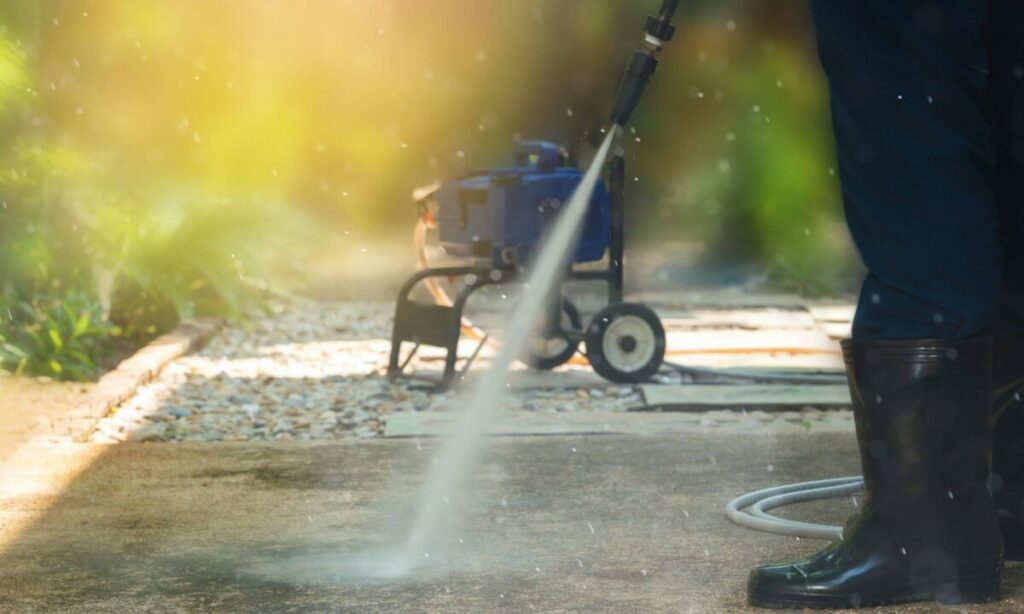Pressure washing is a method of surface cleaning that involves the use of high-pressure water to remove dirt and grime from a variety of surfaces.
It has become increasingly popular in recent years due to its efficiency and convenience.
Pressure washing machines are designed to deliver powerful jets of water at high pressure, making it suitable for cleaning a range of materials including concrete, wood, vinyl, stone and more.
This article will explore the science behind pressure washing by looking at how it works, different types available and the advantages and safety tips associated with this method of cleaning.
Overview of Pressure Washing
Pressure washing is a process that utilizes high-pressure water jets to remove dirt, grime, and other unwanted substances from surfaces. It is an effective method of cleaning many types of materials such as concrete, wood, aluminum, and other surfaces.
Pressure washing works by using a combination of water flow velocity and pressure along with specialized cleaning solutions to break down the bond between surface contaminants like mold, mildew and grease. The resulting effect is an efficient removal of these substances from the surface being cleaned.
The amount of pressure used in the process depends on the type of material that needs to be cleaned as well as what kind of contamination it has been exposed to. For example, softer materials require less pressure than harder ones since they are more prone to damages caused by excessive force. Additionally, the type of cleaning solution used will also determine how effective the pressure washing system will be at removing unwanted particles.
Using hot or cold water can also affect how successful a pressure washer is at cleaning particular materials. Hot water can penetrate deeper into porous materials while cold water better removes oils and greases from hard non-porous surfaces like bricks or stones. Understanding these variables helps ensure that users get maximum results when utilizing a pressure washer for their specific task.
How Does Pressure Washing Work?
Pressure washing is a method of cleaning surfaces using water ejected at high pressure. It is used to remove dirt, mold, and other contaminants from the surface being cleaned. The physics behind pressure washing involves the physics of fluid dynamics in order to understand how the water is pressurized and then released in order to effectively clean the surface.
Pressure washing should not be confused with power washing which typically uses either hot or cold water that has been heated or cooled to extreme temperatures. Both processes are effective for cleaning but have different applications depending on the type of surface being cleaned.
The Physics Behind Pressure Washing
Utilizing the principles of physics, pressure washing has become an effective method for removing dirt and debris from a variety of surfaces.
Pressure washers are powered by water pumps that generate pressure levels up to 40,000 PSI or more. This intense pressure is generated by increasing the speed of the water as it passes through a nozzle with a small diameter opening. The increased speed creates suction, which causes the water to flow faster and create higher pressures.
Additionally, heat can be used in order to increase the effectiveness of pressure washing by increasing the temperature of the water passing through the nozzle. By raising water temperatures up to 200°F or more, dirt and grime can be softened so that they are easier to remove from surfaces like concrete and siding.
The force created by pressurized water is powerful enough to break down tough material such as deep-seated dirt and paint while still being gentle enough not to cause damage to delicate materials like wood decks or stone pavers.
These same physics principles also apply when using detergents with a pressure washer; detergent particles are broken down at high speeds along with dirt and debris on surfaces, making them easier to remove without requiring manual scrubbing or other labor-intensive methods.
As such, pressure washing provides an efficient way for cleaning many different types of surfaces quickly with minimal effort required on behalf of homeowners or contractors alike.
Pressure Washing vs. Power Washing
Comparing pressure washing and power washing, it is important to note the subtle differences between the two techniques. Both are forms of cleaning that use a high-pressure spray of water to remove dirt, debris, and other contaminants from surfaces.
The main difference is in the type of equipment used: pressure washers use cold or warm water, while power washers use hot water.
When determining which cleaning method is more suitable for a particular job, it’s important to consider both temperature and intensity. Cold water pressure washers generally provide enough power for basic cleaning tasks such as removing dirt and grime from siding or outdoor furniture; however they may not be powerful enough to clean tougher stains such as oil or grease.
On the other hand, hot water power washers are capable of tackling these tough stains but can also cause surface bleaching if used incorrectly. In addition, higher temperatures make it possible to achieve better results with less scrubbing effort involved in comparison with colder temperatures.
Different Types of Pressure Washing Machines
A variety of pressure washing machines are available to suit a range of needs, each with distinct features and capabilities.
One type is the cold water pressure washer, which operates at temperatures up to 140°F. This machine is ideal for cleaning non-greasy dirt and grime, and its nozzle size can be adjusted to provide the appropriate water pressure for the task at hand.
Another type is the hot water pressure washer which works best on hard surfaces such as concrete or asphalt and has a temperature range from 130°F to 210°F. It is also equipped with adjustable nozzles which enable it to reach higher levels of cleaning power than its cold water counterpart.
Finally, there are high-pressure machines that can work up to 4000 PSI – these machines are typically used in industrial settings where heavier deposits need removing quickly and efficiently.
No matter what type of machine is chosen, all have one thing in common: they use pressurised jets of water to clean surfaces more effectively than traditional methods like scrubbing or brushing.
Pressure washing machines are designed with safety in mind; their adjustable nozzles allow users to control the amount of force used on any given surface so as not to damage it beyond repair. Some models even feature built-in detergents that help break down dirt before it’s blasted away by the powerful stream of water.
The result? A streak-free finish that looks brand new!
Whether you’re looking for a light-duty machine for occasional home maintenance tasks or an industrial strength model capable of tackling heavy deposits, there’s a pressure washing machine out there that fits your specific needs – all you have to do is find it! With just a bit of research into different types and features available today, anyone can find the perfect tool for their particular job.
Advantages of Pressure Washing
The use of pressure washing machines for surface care has a number of advantages that are worth considering.
A notable advantage is the environmental impact. Pressure washing uses significantly less water than traditional methods when cleaning surfaces, making it both efficient and eco-friendly. This means that not only does it take less time to achieve the same level of cleanliness, but it also conserves resources in the process.
When compared to other methods of surface care, pressure washing offers superior results with a minimum amount of effort. It is able to reach into hard-to-reach areas and scrub away dirt and grime quickly and efficiently without damaging the surface being cleaned.
In addition, because pressure washers are powered by electricity or gas, they can be used in any weather conditions without causing an environmental hazard.
Pressure washing can be used for a variety of applications including cleaning driveways, decks, sidewalks, patios and more. While many people opt to hire a professional service provider for their pressure washing needs due to its effectiveness and efficiency in removing tough stains, there are plenty of DIY options available as well which allows individuals to save money while still achieving satisfactory results from their own home or business premises.
With proper maintenance and usage instructions followed correctly, anyone can make use of this powerful tool for all their surface care needs with minimal effort required on their part.
Safety Tips for Pressure Washing
Safety should be of utmost importance when using a pressure washer, as misuse can result in serious injury or property damage.
For example, not wearing protective gear such as eye protection and gloves could lead to accidental splashes of cleaning solution into unprotected areas.
Additionally, it is important to ensure the area being cleaned is free from any objects that may become damaged due to the high pressure of the water stream produced by a pressure washer.
As such, it is important for users to pay close attention to their surroundings and take appropriate measures before beginning the cleaning process.
Water safety must also be taken into account when using a pressure washer. This applies both indoors and outdoors; all sources of water used with a pressure washer need to have proper connections that are free from leaks or exposed wiring in order to prevent electrocution risk.
Furthermore, if chemicals are used in conjunction with the water stream for cleaning purposes, it is essential for users to familiarize themselves with all instructions on how they should be mixed and applied so as to avoid any chemical hazards that may arise in case of an incorrect mixture ratio or improper application techniques.
When working with a pressure washer, there are several steps that need to be followed for safe operation:
– Reading all instructions carefully before starting up.
– Understanding all safety warnings provided by manufacturers.
– Ensuring user’s clothing does not come into contact with the hot water stream.
– Replacing parts when necessary.
– Avoiding contact between skin and detergents used for cleaning.
– Making sure no electrical devices are plugged into outlets while operating the machine.
If these precautions are taken seriously, then users can safely enjoy all benefits offered by this powerful tool without risking their health or property damage.
Conclusion
Pressure washing is an effective technique for cleaning surfaces. By using a combination of high-pressure water and chemicals, it is possible to remove dirt and debris from hard-to-reach areas. Pressure washers come in various shapes and sizes, making them suitable for all types of applications.
The advantages of pressure washing include time savings, cost savings, improved safety, and better results compared to alternative methods.
It is important to take proper safety precautions when using a pressure washer such as wearing protective gear like goggles and gloves. By following the directions provided by the manufacturer carefully, users can get maximum performance out of their machines while avoiding any damage or injury.
Through careful consideration and use of appropriate techniques like juxtaposition, pressure washing can be used successfully with great results.
- Meet The Founder – Brandon Gawdun - April 12, 2024
- Elevate Your Home: The Next Level Approach to Spring Cleaning - April 12, 2024
- Spring Events – Okanagan - April 12, 2024




